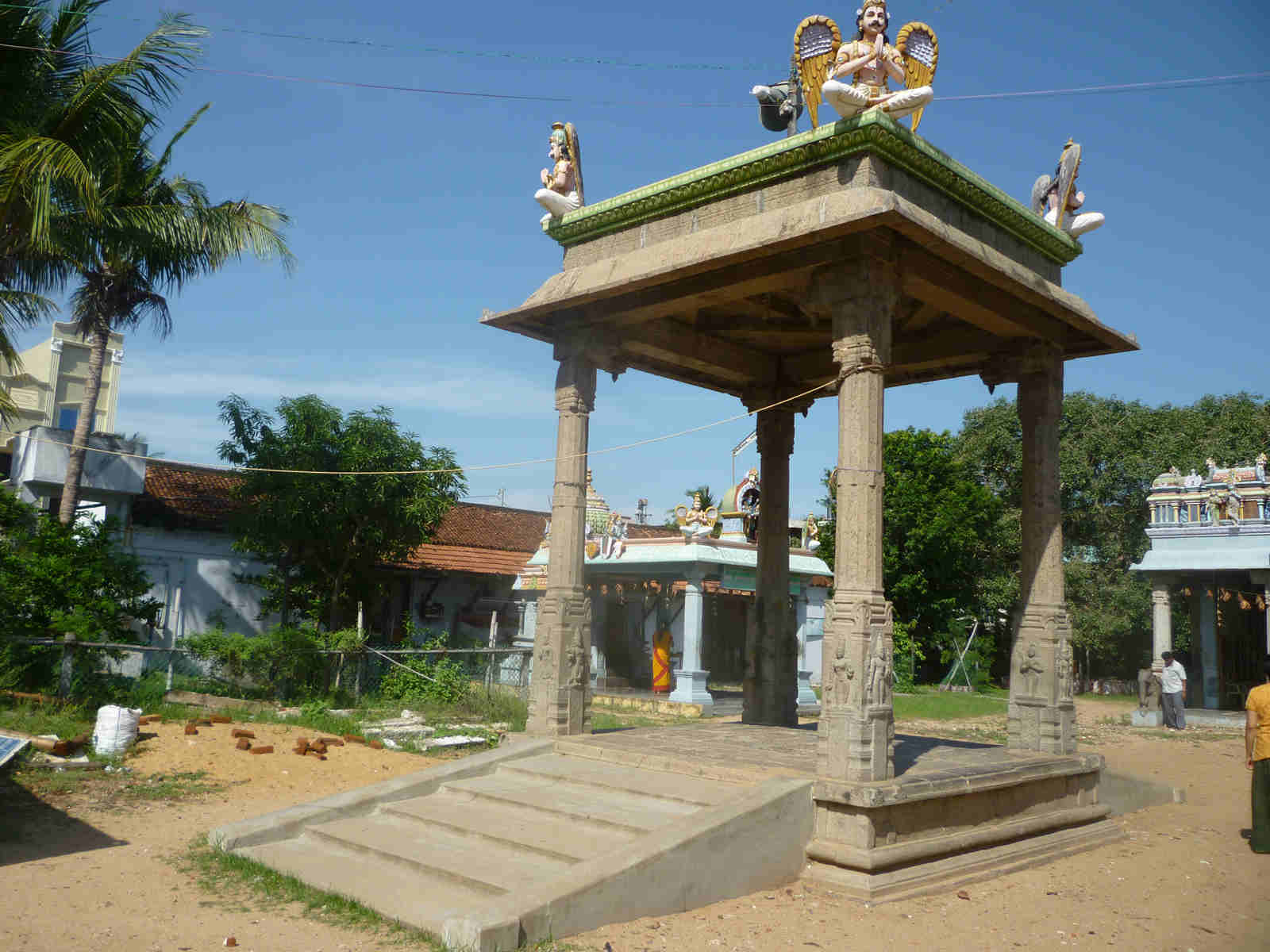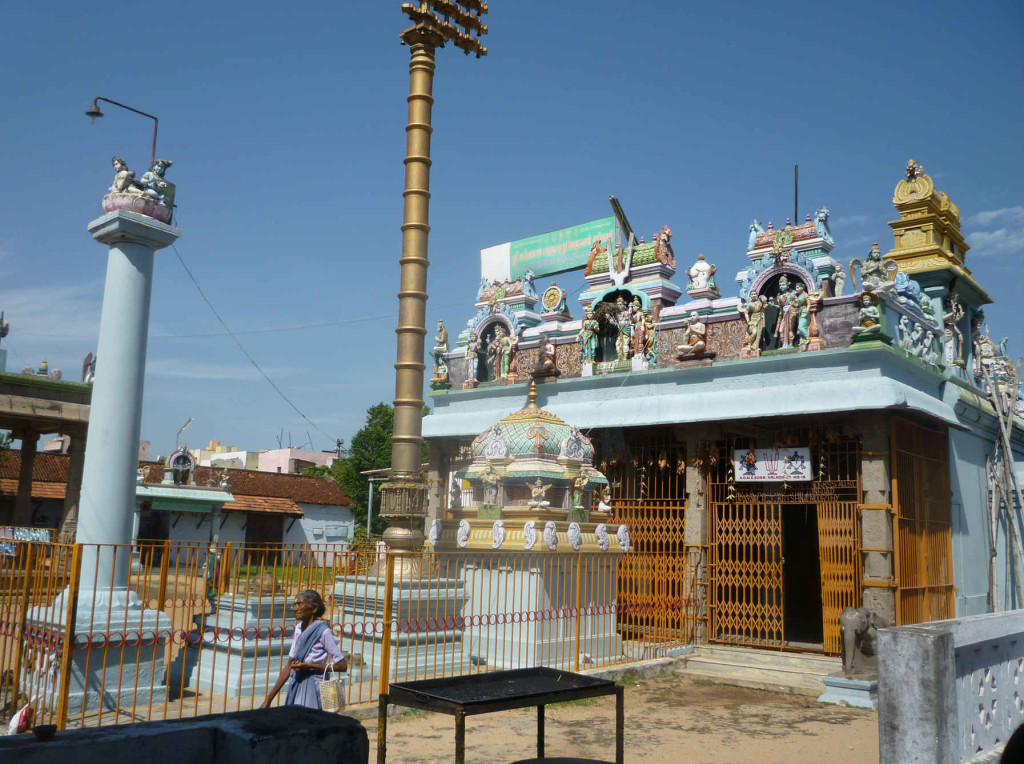Registered with the Registrar of Newspapers for India under R.N.I 53640/91
Vol. XXVII No. 3, May 16-31, 2017
Lost landmarks of Chennai
– Sriram V
An idyll that has vanished

Four-pillared Vahana Mandapam
The founding of Madras that is Chennai may be a matter of debate but not so that of its suburb– Collettpet or Kaladipettai as it is now referred to. Given our tendency to mix facts with fiction, locals aver that the latter name is correct and credit it to the holy feet (kaal) of Ramalinga Swami of Vadalur having walked this area. But he was born only in 1823. Moreover, the founding of this village, now a part of Chennai, is well documented. It was in 1717 that Governor Joseph Collet hit upon the idea of settling weavers from far-flung areas into a local colony. The place, just south of Tiruvottriyur, was named Collettpet after him and that in time morphed into Kulatipettah and still later to Kaladipettai. 2017 therefore marks the tercentenary of its founding.
The Governor is now forgotten but his right-hand man, Viraraghava, or Virago Brahminy as he is referred to East India Company records, is not. For it was entirely due to his efforts that the village got a temple right in its midst. This is dedicated to Kalyana Varadaraja Perumal, the tutelary deity of Kanchi to whom Viraraghava is said to have been greatly attached. That he was also greatly attached to Podala Lingappa, the Governor of Poonamallee who has a street named after him in Kanchipuram, is less well known. That proximity landed Viraraghava in trouble and he was dismissed from his position of Agent of the Company at the Golconda Court. But his closeness to Collet helped and when the latter became Governor in 1717, Viraraghava was reinstated as Telugu Writer to the EIC. This is perhaps the reason why a principal thoroughfare in Collettpet is still called Ezhutthukaran Street.

View of the main shrine at the Kalyana Varadarajaswami Temple, Collettpet.
Collet exempted the settlers from quit rent for three years and also conferred some unspecified “minor privileges”. In its first year of existence the figures were 104 houses, ten shops, a temple and 489 adult inhabitants. Shortly after the moving, Collettpet, along with neighbouring Tiruvottriyur, had to be defended by the EIC from the depredations of Nawab Sadatullah Khan. He was fended off successfully. Collet left India in 1719 and Viraraghava appears to have carried on with expanding the temple, at his personal expense, thereby bringing his family to its knees. We later see his son, Kolacherla Papiah Brahminy, petitioning the Company for relief. He was given hereditary right to manage the temple.
Chances are that very few in Chennai have been to Collettpet. Most vehicles whizz past on the Tiruvottriyur High Road towards the industrial establishments up north. Wandering around the remarkably ugly locality today, for it is full of the most terribly constructed wedding halls, tenements, shops and markets, there is very little that you can trace to its origins. But the street names do point to a rich past. Sannadhi Street is in the middle, leading directly to the temple at the western extremis. At its opposite end, now separated from it by bustling Tiruvottriyur High Road is Market Lane, which leads to the sea. Branching off Sannadhi Street are Vanniyar and Chetty Streets (the regulation banning caste names has not yet been imposed on Collettpet and this is perhaps to the good as all the thoroughfares here would then be reduced to nameless streets) thereby indicating the castes that settled here.
More important is Jandrayar Street, for it tells us something of the weaving past of Collettpet. The Jandras, recognised as a caste now, are traditional weavers from Andhra and as early as the 1680s, Elihu Yale was taking steps to get them to settle in Madras. Collet evidently achieved that. Jandravaru Street would have been its original name and it is now corrupted to Jandrayar Street.
In keeping with its central position in the colony, the Perumal temple has four broad Mada Streets. There are two inner streets that hug the temple walls and these are the North and South Prakaram Streets. The temple faces east and has fronting it a beautiful four-pillared mandapam built in true copy of the Vijayanagar style. The small gopuram that Viraraghava built was demolished a couple of years ago and work is in slow progress on a larger rajagopuram. The temple courtyard has another four-pillared mandapam similar in style to the one outside. There are four sanctums, the biggest being for Kalyana Varadaraja. A stone forecourt has a human figurine in a supplicating posture on one of its pillars. Could this be Viraraghava? The Varadaraja sanctum is flanked by those to Perundevi Thayar and Andal. The latter’s wall has many exam roll numbers scribbled on it, it being a local tradition that the deity helps you to pass. A fourth sanctum, at right angles to the other three, is to Lord Rama. There are smaller sub-shrines to Vaishnavite Acharyas and a modern one to the nine planets. The temple has a tank within the premises, but devoid of water. A stone inscription in Telugu within the temple has it that the vahanamandapam (store house for processional icons), built by Sri Tava Ramanujam Chetty, the son of Venkataraghavulu Chetty, was completed on March 16, 1924. The deities do not have processions now.
In the mid 19th century, Collettpet became a holiday home for the wealthy Arya Vaisyas of George Town. The Calavala and Chimata families in particular had garden houses here. The former were the owners of King & Co. while the latter ran (and still run) Curzon & Co., their kinsmen doing business under the name of Wenlock & Co. In an account of the place, C. Seshachalam Chetty wrote of how it was full of traditional houses with open courtyards and coconut trees. Under the Arya Vaisyas, the arts flourished in Collettpet. Musicians and dancers performed regularly here. A family in residence was that of the eminent musician ‘Tiger’ Varadachariar. In a radio talk given in the 1940s, Tiger reminisced about Collettpet as an atelier and as to how it played an important role in him becoming a musician. His elder brother K.V. Srinivasa Iyengar within a very short life managed to compile one of the best collections of Tyagaraja’s works and publish them. Tiger’s younger brother ‘Puliyodharai’ Krishnamachariar was trained in music thanks to the munificence of the Chimata family and later became a well-known composer. Many of his songs are dedicated to the Kalyana Varadaraja Temple.
Walking around Collettpet today you can only wonder if all this happened. Seshachalam’s idyll has vanished. It is clearly a colony that was once a landmark, now forgotten.

